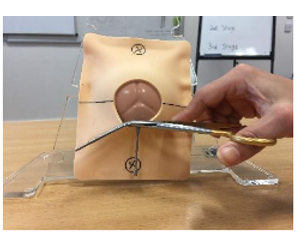

Episcissors- Reducing Obstetric Anal Sphincter Injuries (Oasis) in Instrumental Delivery - Case Study
Hypothesis / aims of study:
To evaluate a new service experience & the rate of Obstetric Anal Sphincter Injuries (OASIS) with the use of Episcissors at
instrumental deliveries.
Study design, materials and methods:
A total of 179 instrumental deliveries were performed between December 2016 & February 2017. Episcissors was used in 67
cases, standard episiotomy pack scissors were used in 98 and in 14 cases no episiotomy was performed. Of the cases where
episcissors were used, the following is a breakdown of the type of deliveries; 13 Ventouse/Kiwi deliveries, 49 Neville Barnes
Forceps (NBF) deliveries, and 4 double instrument deliveries.
Cases were collected from the delivery registrar. An audit proforma was completed to evaluate the rate of OASIS, which included
information on grade of operator, type of instrumental delivery, location (room/theatre) & degree of perineal trauma sustained.
Results
With the use of episcissors, no 4th degree tears sustained over the three month period. One 3b tear was sustained with the use of episcissors for a NBF delivery. This is compared to 4 women who sustained OASIS in the same time period, all delivering by NBF. Two of these women had no episiotomy performed and sustained a 3b and 3c degree tear. In the remaining two cases, episiotomy was performed; episcissors were not used. Both of the patients sustained a 3b tear to the perineum. The overall impression of operators was that the scissors definitely helped with keeping the angle of episiotomy fixed in the safe 40-60 degree range and were easy to use.
Interpretation of results
There was one incident of OASIS with the use of episcissors in the three months studied. This compares with two incidents of
OASIS with the use of standard episiotomy pack scissors.
The data appears supportive for the use of episiotomy in instrumental deliveries, confirming that it reduces the number of tears
sustained, however the time period chosen was short and hence a small number of patients were audited with the use of
episcissors.
Concluding message
This highlights the need for training and education of medical and midwifery staff in the use of episcissors to further evaluate its effect on OASIS. We aim to introduce & evaluate the use of episcissors for all deliveries, instrumental and non-instrumental, in reducing the rate of OASIS. Additionally this data supports the advantage of a safe 60 degree angle of episiotomy from the midline in decreasing OASIS. A larger prospective trial is needed to substantiate these initial results.
Disclosures
Funding: N/A Clinical Trial: No Subjects: HUMAN Ethics not Req`d: It was a retrospective study examining new service
provision. Helsinki: Yes Informed Consent: Yes

